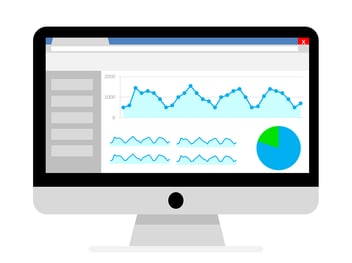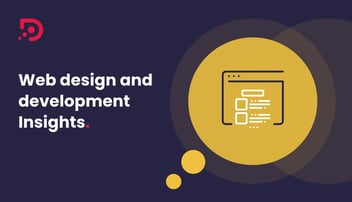3 Web Page Design Tips for Increased Conversion Rates
Ask most business owners how to increase their conversion rates and they’ll probably say two things: good content and good SEO.
But guess what?
This answer overlooks a crucial aspect of a web experience geared toward conversion: design and development.
In this article, we’ll share three tangible areas where readers and webmasters alike can make improvements to shift website design from hurting their marketing efforts to helping them.
Here’s what we’ll cover:
- Why web page design is important
- The power of simplicity
- Keeping people on your site for longer
- Guiding visitors to the content they need
- How Digital Media Stream can help your business with growth-driven design
If you want to skip the reading and jump straight into a consultation with our web design & development team, click here.
Why Web Page Design Is So Important
First, let’s take a look at some success metrics from UX and UI redesign projects:
-
- Virgin America saw a 14% increase in conversion rate and a 20% decrease in support calls.
- HubSpot’s conversion rate increased two- or even three-fold.
- Continental Office increased traffic by 103% YOY and new contacts by an incredible 645%
These figures, cited by Top Total, are phenomenal.
What would a 103% YOY traffic boost look like for your site? Or a 14% increase in conversion rate?
In the world of B2B, your website should be your most reliable salesperson, and these stats prove beyond doubt that in an increasingly online world, UX and UI are no longer optional considerations. If you ignore them, you will be left behind.
In the following sections, we’ll share three focus areas to help you determine how well your site is converting, and more importantly, how you can identify and remedy any issues.
1. Simplicity Underscores Great Web Page Design
Have you heard of the KISS factor? Keep It Simple, Silly!
We’re not suggesting anyone reading this is silly, of course, but the first three words capture the essence of effective web design: simplicity. An overcrowded website is the best way to ensure low conversions.
But what does simplicity look like?
To answer this question we’ll defer to industry-leading websites with near-endless design budgets and presumably gargantuan conversion rates.
Here’s how some of the pros do it:
This is the Google Design blog, a showcase of expertise from designers, writers, and developers who are trying to advance good web design.
What they do well:
-
- Lots of white space
- Limited and relevant pop-ups
- Functional, easy-to-use navigation
This is Owl, a fictional brand showcasing the capabilities of Material Design. Material is a design language created by Google in an attempt to define UI best practices.
You can read the full philosophy behind the Owl branding here, but let us summarise just what’s so powerful about the design:
-
- Bold colour and shape
- Navigational cues provided by colour to encourage easy engagement
- Concise copy with a can-do tone
Simple design comes down to a few core concepts. It’s about striking a balance between providing info and not over-complicating things. An overly busy layout, too many bold and inconsistent colours, or overly aggressive CTAs will turn users away.
Achieving Simplicity in B2B Web Page Design
Simple web design makes it much easier for visitors to use your site. Here’s how to do it:
-
- On-brand colour palette, used consistently
- Intuitive and easy-to-use navigation
- Plenty of white space, avoid overcrowding
- A clear, professional, and easy-to-read font
- Fully responsive design for a consistent experience across devices
- Compressed images to streamline page load time
- Lazy loading images to further increase page speed
- Include a search bar in your 404 to stop dead-end user journeys
- Easy-to-use chat and contact details
- Minimal distracting and invasive popups
2. Great Website Design Leads to Increased Visit Duration
Let’s define two key terms:
-
- Time on page: the average time all users spend on a page
- Session duration: the total duration of sessions divided by the total number of sessions
Both are important and each has different uses, but growth-driven design usually focuses on increasing session duration.
And here’s why:
Good design includes elements that allow the user to get the answers they need and pre-qualify themselves before leaving the site. Low duration can be an indication that you’re attracting many visitors, but your site is letting them down: a poor trust signal that tells Google your website isn’t meeting users’ needs.
According to a report by Content Square, the average session duration for B2B is 2.28 minutes. How does that compare with your metrics?
(And if you don’t know the answer, make sure this metric is being tracked!)
Increase Visit Duration and Other Website Analytics Benchmarks
With every additional second a user stays on your site, the chances of converting them increases. Here’s how to keep them around longer:
-
- Ensure dropdown menus work and are easy to use
- Imagine yourself as the buyer, and answer all their questions about product info, pricing, benefits and so on
- Implement internal linking best practices
- Use compelling CTAs
- Ensure there are no broken links
- Optimise for mobile
- Implement breadcrumbs so users can navigate easily
- Use an exit-intent popup to capture users as they leave
3. Great Website Design Can Reduce Bounce Rates & Exit Rates
Let us define these terms as well:
-
- Bounce rate: the percentage of visitors who leave a website after viewing only one page
-
- Exit rate: the percentage of visitors who exit a website from a specific page, regardless of how many pages they viewed previously
- Exit rate: the percentage of visitors who exit a website from a specific page, regardless of how many pages they viewed previously
Pages on your site should have a natural flow that leads users to other related content, or to perform an on-site action like submitting their details or downloading a resource.
Your design will need to facilitate this. Like so:
Need results but pressed for time? Book a 15-minute consultation with our web development and design team, and we’ll talk you through how we can increase your conversions.
(See what we did there? 😉)
Reducing bounce rate and exit rate is about ensuring visitors’ needs are met, and that your design facilitates smooth interaction. It should be easy to locate, navigate to, and engage with any content the user requires, and from there it should be intuitive to move further along the funnel.
Essentially, any need must be met as quickly as possible, otherwise, the visitor will hit the back button and look elsewhere.
How To Reduce Bounce Rate and Exit Rate Through Design
Keeping visitors on your website once you’ve attracted them there is crucial. Here’s how to keep them on board:
-
- Use CTAs that focus on lead capture. Think pop-ups, buttons triggered at a certain scroll depth, or even a static banner.
- Ensure design meets intent so that people stick around
- Make sure there’s a reason for visitors to stay: offers, compelling CTAs and assets for download, for example
- Keep load speed at a minimum: anything over 3 seconds will cause a user to leave
- Audit your page speed using Page Speed Insights or Lighthouse
- Implement technical tweaks, like caching and removing redirect loops & chains
- Compress and minify CSS and JS assets
- Compress images
How Digital Media Stream's Growth-Driven Design Can Support Your Marketing Goals
Our digital expertise, coupled with HubSpot credentials and knowledge of industry tools position our experienced team to deliver the best B2B website design and development that drive higher conversion rates
Book a call with our experts to chat about your needs, and how we can help you improve conversion rates by design.




